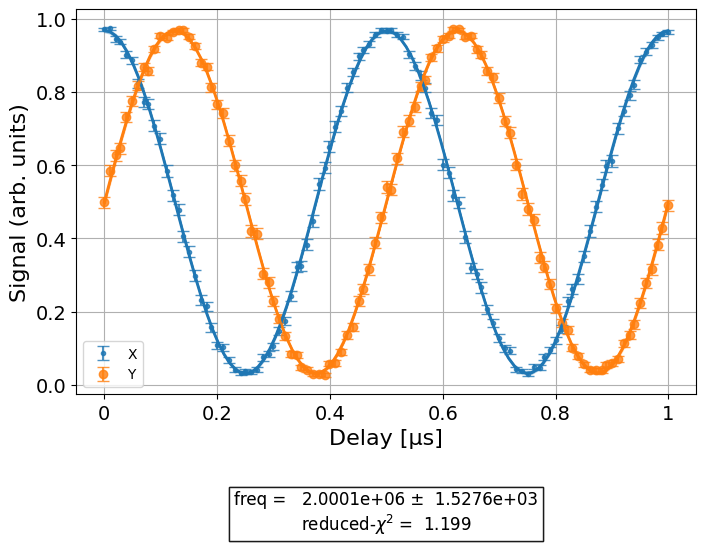RamseyXY¶
- class RamseyXY(physical_qubits, backend=None, delays=None, osc_freq=2000000.0)[source]¶
A sign-sensitive experiment to measure the frequency of a qubit.
Overview
This experiment differs from the
T2Ramseysince it is sensitive to the sign of the frequency offset from the main transition. This experiment consists of following two circuits:(Ramsey X) The second pulse rotates by pi-half around the X axis ┌────┐┌─────────────┐┌───────┐┌────┐ ░ ┌─┐ q_0: ┤ √X ├┤ Delay(τ[s]) ├┤ Rz(θ) ├┤ √X ├─░─┤M├ └────┘└─────────────┘└───────┘└────┘ ░ └╥┘ measure: 1/════════════════════════════════════════╩═ 0 (Ramsey Y) The second pulse rotates by pi-half around the Y axis ┌────┐┌─────────────┐┌───────────┐┌────┐ ░ ┌─┐ q_0: ┤ √X ├┤ Delay(τ[s]) ├┤ Rz(θ-π/2) ├┤ √X ├─░─┤M├ └────┘└─────────────┘└───────────┘└────┘ ░ └╥┘ measure: 1/════════════════════════════════════════════╩═ 0The first and second circuits measure the expectation value along the -Y and X axes, respectively. This experiment therefore tracks the dynamics of the Bloch vector around the equator. The drive frequency of the control electronics defines a reference frame, which differs from the true qubit frequency by \(\Delta\omega\). The Hamiltonian during the
Delayinstruction is \(H^R = - \frac{1}{2} \Delta\omega\) in the rotating frame, and the propagator will be \(U(\tau) = \exp(-iH^R\tau / \hbar)\) where \(\tau\) is the duration of the delay. By scanning this duration, we can get\[\begin{split}{\cal E}_x(\tau) = {\rm Re} {\rm Tr}\left( Y U \rho U^\dagger \right) &= - \cos(\Delta\omega\tau) = \sin(\Delta\omega\tau - \frac{\pi}{2}), \\ {\cal E}_y(\tau) = {\rm Re} {\rm Tr}\left( X U \rho U^\dagger \right) &= \sin(\Delta\omega\tau),\end{split}\]where \(\rho\) is prepared by the first \(\sqrt{\rm X}\) gate. Note that phase difference of these two outcomes \({\cal E}_x, {\cal E}_y\) depends on the sign and the magnitude of the frequency offset \(\Delta\omega\). By contrast, the measured data in the standard Ramsey experiment does not depend on the sign of \(\Delta\omega\), because \(\cos(-\Delta\omega\tau) = \cos(\Delta\omega\tau)\).
The experiment also allows users to add a small frequency offset to better resolve any oscillations. This is implemented by a virtual Z rotation in the circuits. In the circuit above it appears as the delay-dependent angle θ(τ).
Analysis class reference
Experiment options
These options can be set by the
set_experiment_options()method.- Options
Defined in the class
RamseyXY:delays (list)
Default value:array(0.0, 2e-08, 4e-08, 6.000000000000001e-08, 8e-08, ..., size=51)The list of delays that will be scanned in the experiment, in seconds.osc_freq (float)
Default value:2000000.0A frequency shift in Hz that will be applied by means of a virtual Z rotation to increase the frequency of the measured oscillation.
Defined in the class
BaseExperiment:max_circuits (Optional[int])
Default value:NoneThe maximum number of circuits per job when running an experiment on a backend.
Example
import numpy as np from qiskit_experiments.library.characterization import RamseyXY delays = np.linspace(0, 10.e-7, 21) exp = RamseyXY((0,), backend=backend, delays=delays, osc_freq=2.0e6) exp_data = exp.run().block_for_results() display(exp_data.figure(0)) exp_data.analysis_results(dataframe=True)

name experiment components value quality backend run_time chisq 6a638b2a freq RamseyXY [Q0] 2100464.0166951865+/-nan good T2Hahn_simulator None 1.026735 Initialization
Create new experiment.
- Parameters:
physical_qubits (Sequence[int]) – List containing the qubit on which to run the Ramsey XY experiment.
backend (Backend | None) – Optional, the backend to run the experiment on.
delays (List | None) – The delays to scan, in seconds.
osc_freq (float) – the oscillation frequency induced by the user through a virtual Rz rotation. This quantity is given in Hz.
Attributes
- analysis¶
Return the analysis instance for the experiment
- backend¶
Return the backend for the experiment
- experiment_options¶
Return the options for the experiment.
- experiment_type¶
Return experiment type.
- num_qubits¶
Return the number of qubits for the experiment.
- physical_qubits¶
Return the device qubits for the experiment.
Methods
- circuits()[source]¶
Create the circuits for the Ramsey XY characterization experiment.
- Returns:
A list of circuits with a variable delay.
- Return type:
List[QuantumCircuit]
- config()¶
Return the config dataclass for this experiment
- Return type:
- copy()¶
Return a copy of the experiment
- Return type:
- classmethod from_config(config)¶
Initialize an experiment from experiment config
- Return type:
- job_info(backend=None)¶
Get information about job distribution for the experiment on a specific backend.
- Parameters:
backend (Backend) – Optional, the backend for which to get job distribution information. If not specified, the experiment must already have a set backend.
- Returns:
A dictionary containing information about job distribution.
”Total number of circuits in the experiment”: Total number of circuits in the experiment.
”Maximum number of circuits per job”: Maximum number of circuits in one job based on backend and experiment settings.
”Total number of jobs”: Number of jobs needed to run this experiment on the currently set backend.
- Return type:
dict
- Raises:
QiskitError – if backend is not specified.
- run(backend=None, sampler=None, analysis='default', timeout=None, backend_run=None, **run_options)¶
Run an experiment and perform analysis.
- Parameters:
backend (Backend | None) – Optional, the backend to run on. Will override existing backend settings.
sampler (BaseSamplerV2 | None) – Optional, the sampler to run the experiment on. If None then a sampler will be invoked from previously set backend
analysis (BaseAnalysis | None) – Optional, a custom analysis instance to use for performing analysis. If None analysis will not be run. If
"default"the experimentsanalysis()instance will be used if it contains one.timeout (float | None) – Time to wait for experiment jobs to finish running before cancelling.
backend_run (bool | None) – Use backend run (temp option for testing)
run_options – backend runtime options used for circuit execution.
- Returns:
The experiment data object.
- Raises:
QiskitError – If experiment is run with an incompatible existing ExperimentData container.
- Return type:
- set_experiment_options(**fields)¶
Set the experiment options.
- Parameters:
fields – The fields to update the options
- Raises:
AttributeError – If the field passed in is not a supported options
- set_run_options(**fields)¶
Set options values for the experiment
run()method.- Parameters:
fields – The fields to update the options
See also
The Setting options for your experiment guide for code example.
- set_transpile_options(**fields)¶
Set the transpiler options for
run()method.- Parameters:
fields – The fields to update the options
- Raises:
QiskitError – If initial_layout is one of the fields.
See also
The Setting options for your experiment guide for code example.